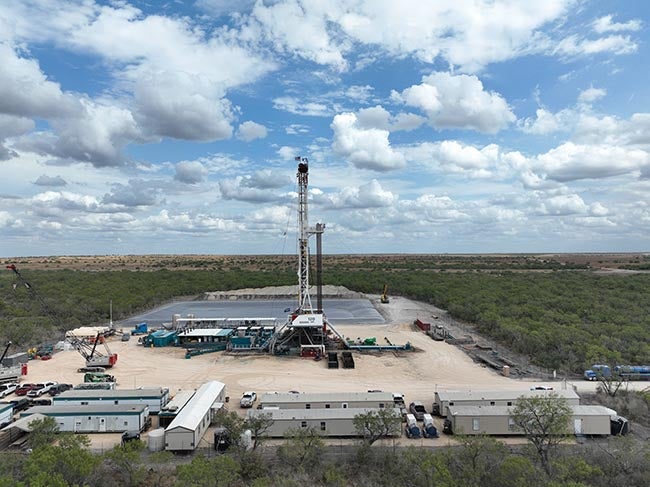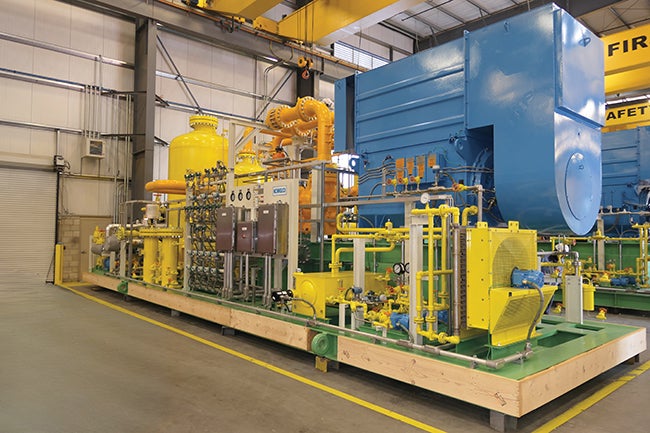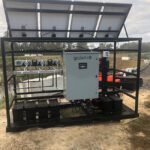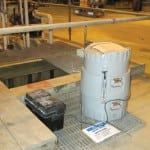Total suspended solids probe can help coal-fired power plants reduce compliance risks and avoid additional sampling.
Water plays an essential role in coal ash remediation, but managing that process often comes with challenges. Power plant operators are continuously seeking ways to safely remediate unlined coal ash basins, while reducing risks and expenses. The emergence of next-generation total suspended solids (TSS) monitoring technology is helping power plant operators reduce the cost and compliance burdens associated with coal ash pond remediation.
TSS is the primary parameter for verifying effluent quality in regulatory discharge permits for coal ash remediation. The need to consistently meet TSS discharge limits, and avoid fines and other potential liabilities, requires substantial field data collection, verification, documentation, and reporting.
Testing Lag-Time Increases Risks
Most coal combustion residuals (CCR) operations either retain or release plant effluent based on TSS test results. Those tests require at least a day to complete, but frequently take two or three days. The existing TSS testing method for compliance verification is a time-consuming laboratory test that cannot be completed in the field, unless by mobile-certified field labs. This inherent lag-time between sampling and verification brings unknowns to the remediation process, often necessitating more cost, field sampling, and testing (erring on the side of over-compliance) than a plant’s permit requires. It also raises the potential for risky bottlenecks in overall remediation operations.
As part of permit specifications, most plants have maximum allowable discharge flow rates—only a certain number of gallons can be discharged in any 24-hour period (Figure 1). The permitted discharge volume depends primarily on the regulatory designation of the receiving stream and the characteristics of the plant’s wastewater effluent. Once a plant has met its allowable discharge for the day, pumps must be turned off until the next day.
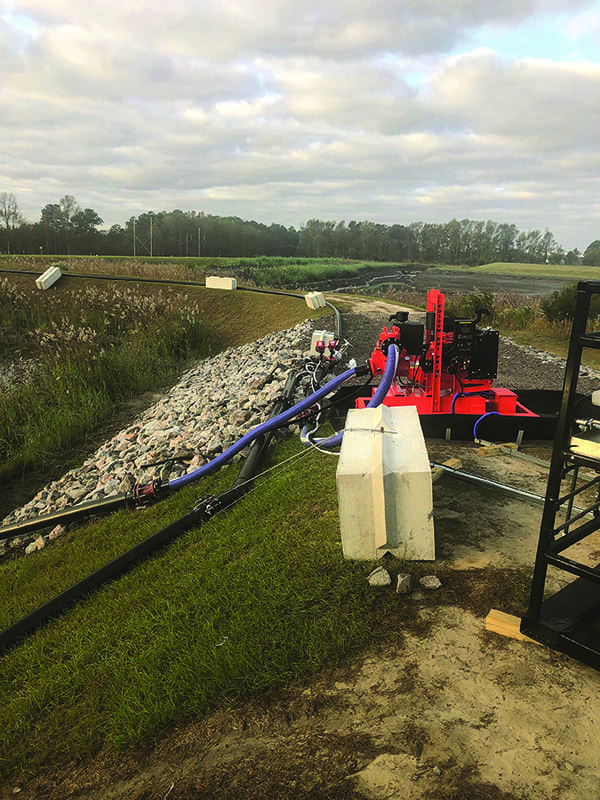 |
|
1. A Godwin diesel-powered pump is shown here being used to remove ash pond water from a clear pond and pump to outfall with a Xylem pretreatment control system ensuring the water being discharged meets site permit limits. Courtesy: Xylem Inc. |
Discharge permits contain both a daily and monthly TSS limit. Additionally, most remediation operations have established their own internal limit, or daily high, set below the regulatory permit limit to provide a margin of protection against violations. Because of the significant lag-time between gathering field samples and final laboratory TSS analysis, many facilities resort to this expensive and burdensome over-compliance strategy.
For example, let’s assume a lab result from a sample pulled two days earlier shows TSS levels above a facility’s internally established limit, or worse, its permit limit. At that point, operations would stop discharging for an extended period of time to compensate. Because TSS monthly regulatory reporting is based on a time-weighted average, the plant receives a zero for TSS discharge reporting for those days when pumps are off, thereby averaging out daily TSS levels to meet the monthly permit requirement.
Excessive zero days can lead to high containment levels that can intensify the potential for serious issues such as a pond breach during severe weather events. Additionally, when the facility needs to discharge its effluent but can’t, the retaining basin or pond fills up with more water that must be pumped. Due to its daily maximum allowable discharge limit, a plant cannot get those zero days back by increasing the pump schedule on other days to make up the difference. It’s a vicious cycle.
Depending on permits, some locations test TSS levels several times per day. Other locations test several times a week. In either case, testing requires manpower to pull samples. The facility must rely on an outside laboratory or perform the test in-house, which requires having a certified lab. To reduce lag-time, some facilities contract mobile-certified labs to be onsite fulltime to handle effluent testing. Regardless of how lab tests are done, it’s an expensive, labor-intensive process.
Probe-Based, Real-Time TSS Measurement
To reduce these high costs and compliance risks, some coal-fired power plants are successfully adopting suspended solids sensors that use an optical backscatter technique to measure real-time TSS to verify their discharge water is meeting specified requirements.
TSS is a physical laboratory measurement; it defines the actual weight of suspended material in a given volume of water. The measurement derived from the optical sensor is not an absolute unit. However, TSS has a linear relationship with the scattering and backscattering coefficients of light. Light-scattering technology differentiates samples based on refractive index, size, shape, and composition. Backscattering is a method of light-scattering measurement that correlates with TSS. The field probe reads the light measurements as a suspended solids value based on the calibration against laboratory grab-sample analysis.
Real-time, probe-based TSS monitoring eliminates the need for frequent sampling and laboratory testing (see sidebar). Along with reducing compliance risks and costs, coal-fired power plants avoid costly project delays resulting from lengthy lab analysis procedures.
|
Real-Time TSS Monitoring Benefits Utility When state regulators issued new discharge permits for a major power utility’s ash basin, the remote location and its lack of permanent power made it extremely challenging to comply. The utility needed a system that could remove water from an ash basin where precipitation continued to enter, as well as meet the new water quality requirements for TSS and pH. A dewatering system that offered pre-treatment was needed to maintain water quality until a full-scale water treatment facility was required. This system had to be able to monitor several variables, such as pond level, TSS, pH, and daily discharge limits. Additionally, the system had to be fully automated and monitored continuously during operation. To provide complete control of the system, Xylem built a custom control panel with an HMI (human-machine interface). The addition of automated valves to the system eliminated the need for an operator except for daily starting and stopping of the system. If water quality limits were approached, the system would begin dosing the needed chemical to adjust the water quality. If readings continued to climb, the system would send out an alarm, actuate the valves, and go into recirculation mode back to the raw water source until water quality improved. Once levels returned to normal, the system would start discharging again. YSI TSS and pH probes ensured water quality of the effluent. |
Boosting Performance
TSS in water can be detected by a number of optical-sensing techniques, and it has been understood for many years that TSS and the backscattering coefficient correlate well. However, early instruments using this method did not fare well in harsh applications like coal ash remediation. The poor performance was due to shortfalls in electronics, light source and other materials of construction, and control algorithms. Difficulty keeping the sensor’s lens clean while operating in real-world environments also contributed to sensing limitations of early units.
The pressures to meet new, increasingly stringent government regulations prompted Xylem to concentrate its research and development efforts toward further improving and stabilizing the backscatter method for TSS prediction. This also resulted in improved protection for the probe against interferences brought by severe operating conditions. Xylem’s technical team successfully eliminated and compensated for the most common sources of instability through the use of light-scatter and backscatter measurement methods, advancements in light-emitting diode (LED) technology, the development of a comprehensive algorithm to determine the relationship between measured TSS and predicted TSS, and an advanced sonic lens cleaning system. As a result, Xylem’s YSI IQ SensorNet ViSolid Suspended Solids Probe is now being used in harsh wastewater streams to consistently and accurately measure TSS in real time with a repeatability of less than 0.015% or greater than 0.0006% FNU (Formazin Nephelometric Unit).
Because the sensor measures TSS concentrations in real time with consistent accuracy close to that of laboratory analysis, some operators have modified upstream processes, such as flocculent dosing, for higher treatment and remediation efficiencies.
Automating Functions
Having the ability to monitor TSS in real time, and obtain accurate results that are repeatable and verifiable with random lab tests, also enables users to automate functions, such as controlling pumps transporting effluent, or start and stop pretreatment processes designed to keep effluent within permit guidelines (Figure 2).
 |
|
2. A Xylem custom control panel is shown here with a solar array and chemical injection pumps at a remote ash pond site. Courtesy: Xylem Inc. |
Real-time TSS measurement, for example, can allow for automated polymer dosage control, based on the probe’s continuous TSS measurements. If effluent TSS levels get too high, systems have been designed using the probe to automatically stop the transfer pump and instead recirculate the flow within the retaining pond while automatically dosing a flocculent, thereby making the solids further accumulate and drop out of solution.
The same control system serving the TSS probe can simultaneously measure pH (by adding a pH probe). If effluent pH is too high or too low, the controller can be programmed to turn on a small pump to add acid or base for pH adjustment to ensure upper and lower pH permit limits are being met.
With online TSS monitoring, power plants are no longer required to rely on offsite or mobile laboratories for TSS analysis. This greatly reduces the need for extensive personnel to attain samples in remote locations, instead enabling operators to log in remotely for monitoring or troubleshooting purposes.
An ‘Optical Fingerprint’
Accurate online, optical sensor-based TSS monitoring provides a real-time measurement of effluent TSS that can be used as an operation and management parameter for complying with regulatory requirements.
Continuous TSS measurement also provides plant owners with the potential for significant operational efficiencies and cost reductions. Sampling and laboratory testing exceeding the number of random samples needed to meet permit requirements are no longer necessary, freeing up workforce and laboratory costs. The long-term reliability of the measurement also enables the automation of certain functions, such as the control of transport pumps and valves, and the starting and stopping of chemical pretreatment processes, further reducing costs and boosting efficiencies.
Real-time TSS monitoring also provides ongoing backup documentation—an optical fingerprint—providing a real-time effluent discharge record that can validate compliance reporting and defend against potential legal action. Furthermore, it can be used to demonstrate a plant’s good faith in exceeding its permit requirements—demonstrating the plant is being a good steward of the environment. ■
—Chris Bauman is a controls design engineer, Dave Donahue is an outside sales representative, and Dave Fraley is the regional sales manager for the southeastern U.S. with Xylem Inc. (www.xylem.com).







